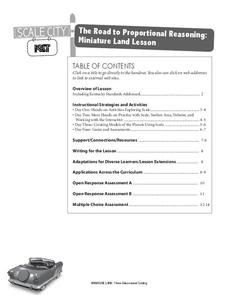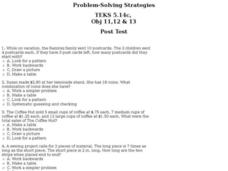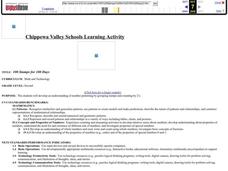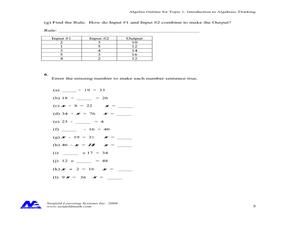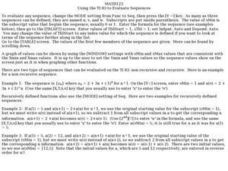Curated OER
It Has Been Rubbish For Years
Students are presented with the problems of percentages and focus upon numbers in contrast to 100. They calculate problems with money and are engaged with the use of games as a teaching tool. Students also interpret data as presented in...
Kentucky Educational Television
The Road to Proportional Reasoning
Just how big would it really be? Young mathematicians determine if different toys are proportional and if their scale is accurate. They solve problems relating scale along with volume and surface area using manipulatives. The...
Curated OER
Voter Turnout
Explore politics by analyzing the voting process. Pupils discuss the purpose of casting votes in an election, then examine graphs based on the data from a previously held election's turnout. The activity concludes as they answer study...
Illustrative Mathematics
Hand Span Measures
How long is your hand span? Young mathematicians measure their hand span from pinky tip to thumb tip using a centimeter ruler. After rounding to the nearest whole centimeter, learners plot their data on a line plot.
Curated OER
Buying a Car
Eighth graders create spreadsheets to calculate payments. They create a list of items they would like to purchase that require monthly payments. They simulate buying a car and create a spreadsheet to determine the amount of the monthly...
Curated OER
Problem Solving Strategies: Pre Test
In this problem solving worksheet, students answer multiple choice questions about math word problems and choosing the best strategy to solve them. Students answer 10 questions total.
Curated OER
Problem Solving Strategies Post Test
In this problem solving strategies worksheet, students answer a set of 10 multiple choice questions. Students may click on a link to see correct answers.
Curated OER
"Adding It Up" at James Fort
Students discuss jettons and their archaeological importance at Jamestown. They then practice using historic counting sheets and artifacts to understand the calculating methods of the early 17th Century, and identify their similarities...
Curated OER
Introduction to Arithmetic and Geometric Sequences
Learners examine the concept of sequences. Students create a sequence using varied starting numbers, multipliers, and add on values. Learners practice determining the starting values to use in order to produce a desired sequence.
Curated OER
100 Stamps for 100 Days
Second graders count by 2's to get to 100. In this counting lesson plan, 2nd graders use the program Kid Pix to create stamps two at a time until they get to 100.
Curated OER
Multiplying By Whole Tens
In this multiplying worksheet, pupils count by tens, write the rule for multiplying by ten, and then multiply numbers by ten. Examples and explanations are given prior to the exercise. This two-page worksheet contains approximately 30...
Curated OER
The Square-Patio Company
In this designing a square patio instructional activity, 10th graders solve 5 different word problems related to designing this patio. First, they use quadrille paper to make a few models such as a patio of side 1 foot. Then, students...
Curated OER
Dividing
Fifth graders explore the inverse proportional relationship and direct proportional relationship. They complete division chart showing the inverse relationship and direct relationship. Students are shown that division problems can be...
Curated OER
Seized Before Flights: Graph
In this bar graph worksheet, students analyze a graph that show the number of prohibited items intercepted at U.S. airport screening checkpoints. Students answer 3 problem solving questions about the data on the graph.
Curated OER
Introduction to Algebraic Thinking
In this introduction to algebraic thinking, students perform given calculations. They draw a sequence of pictures to explain the equation. This five page worksheet contains six multi-step problems.
Curated OER
Shell Sort; Serving up Seafood
Students complete various small group activities to classify items and determine the types of combinations that can be made with these items. In the second lesson, students create menus for a restaurant to help them gain money sense and...
Curated OER
Using the TI-83 to Evaluate Sequences
In this evaluating sequences worksheet, students use the TI-83 graphing calculator to evaluate sequences. Instructions on how to use the calculator with these type of problems is provided. There are three problems on this one-page...
Curated OER
Transformations and Exponential Functions
Tenth graders study graphing exponential functions. In this transformations instructional activity, 10th graders apply inquiry to determine how changes to a parent function affect its graph. Students analyze transformed graphs and...
Curated OER
The Apple Orchard Problem
Students explore various approaches to solving a problem of maximizing the total production of apples in an orchard. In this apple orchard lesson, students collect data in order to solve the apple orchard problem presented. Students plot...
Curated OER
Product + 1: Integers
In this integers instructional activity, students solve 1 word problem using proof. Students prove their hypothesis of the result of multiplying four consecutive positive integers and adding one to the product.
Curated OER
Tennis Tournament
In this secondary mathematics instructional activity, students determine the how many matches that must be palyed in a tennis tournament given the number of players and the tournament constraints. The one page...
Curated OER
Ratios Involving the Hypotenuse
For this trigonometry worksheet, 10th graders calculate the ratios as it relates to the hypotenuse of the triangle. They find the missing leg, angle or hypotenuse. There are 6 questions with this worksheet.
Curated OER
A Penny Saved is a Penny Earned
Students explore the concept of exponential growth. For this exponential growth lesson, students manipulate power models with base 2. Students discuss what would happen if you doubled a penny over the course of 20 days. ...
Curated OER
Count The Letters
Young scholars perform activities involving ratios, proportions and percents. Given a newspaper article, groups of students count the number of letters in a given area. They use calculators and data collected to construct a pie chart...

